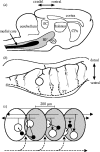The brainstem reticular formation is a small-world, not scale-free, network
- PMID: 16615219
- PMCID: PMC1560205
- DOI: 10.1098/rspb.2005.3354
The brainstem reticular formation is a small-world, not scale-free, network
Abstract
Recently, it has been demonstrated that several complex systems may have simple graph-theoretic characterizations as so-called 'small-world' and 'scale-free' networks. These networks have also been applied to the gross neural connectivity between primate cortical areas and the nervous system of Caenorhabditis elegans. Here, we extend this work to a specific neural circuit of the vertebrate brain--the medial reticular formation (RF) of the brainstem--and, in doing so, we have made three key contributions. First, this work constitutes the first model (and quantitative review) of this important brain structure for over three decades. Second, we have developed the first graph-theoretic analysis of vertebrate brain connectivity at the neural network level. Third, we propose simple metrics to quantitatively assess the extent to which the networks studied are small-world or scale-free. We conclude that the medial RF is configured to create small-world (implying coherent rapid-processing capabilities), but not scale-free, type networks under assumptions which are amenable to quantitative measurement.
Figures





References
-
- Albert R, Barabasi A.-L. Statistical mechanics of complex networks. Rev. Mod. Phys. 2002;74:47–97. doi:10.1103/RevModPhys.74.47 - DOI
-
- Amaral L.A, Scala A, Barthelemy M, Stanley H.E. Classes of small-world networks. Proc. Natl Acad. Sci. USA. 2000;97:11 149–11 152. doi:10.1073/pnas.200327197 - DOI - PMC - PubMed
-
- Ascoli G. Progress and perspectives in computational neuroanatomy. Anat. Rec. 1999;257:195–207. doi:10.1002/(SICI)1097-0185(19991215)257:6<195::AID-AR5>3.0.CO;2-H - DOI - PubMed
-
- Barabasi A.-L, Albert R. Emergence of scaling in random networks. Science. 1999;286:509–512. doi:10.1126/science.286.5439.509 - DOI - PubMed
Publication types
MeSH terms
LinkOut - more resources
Full Text Sources
Molecular Biology Databases
